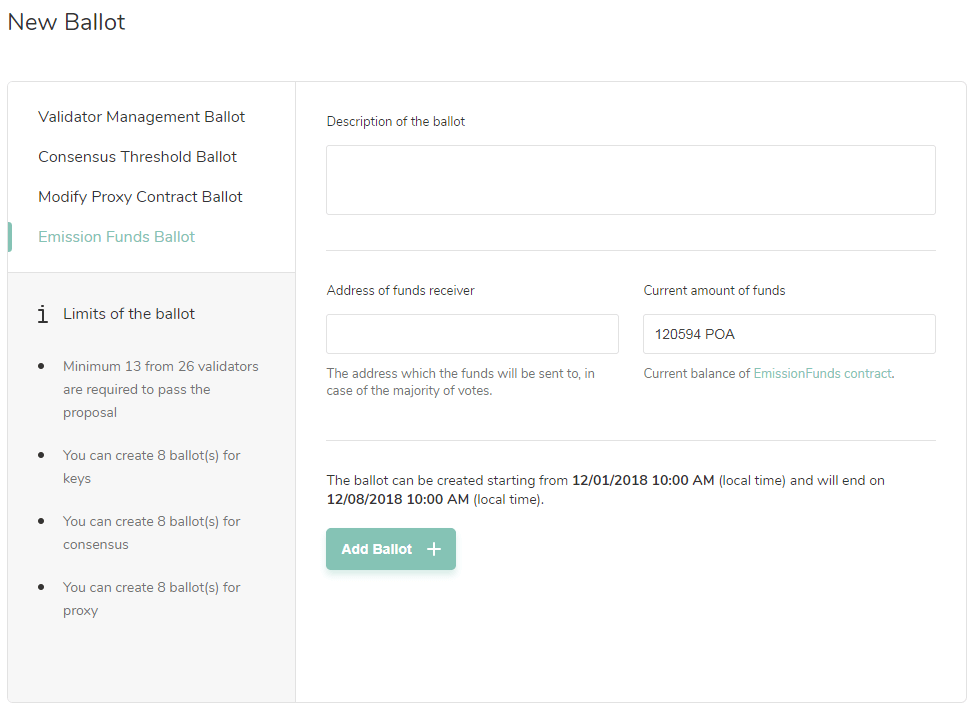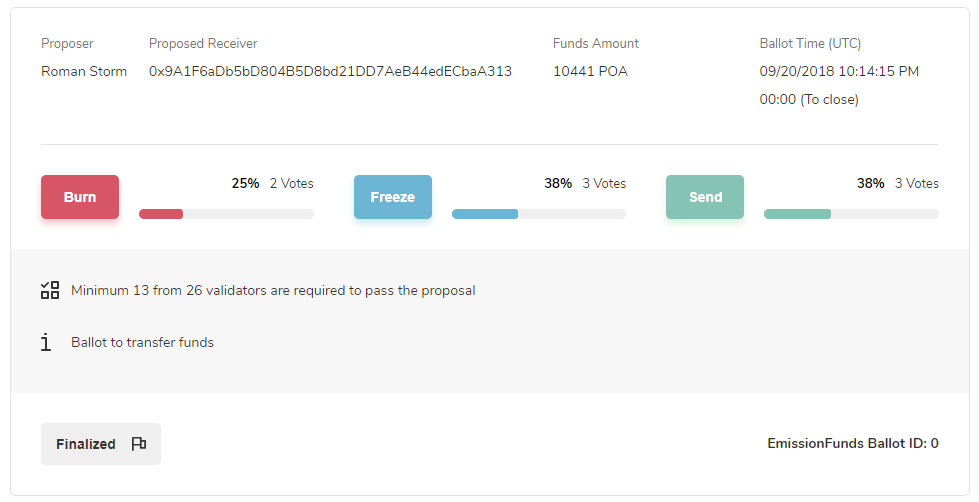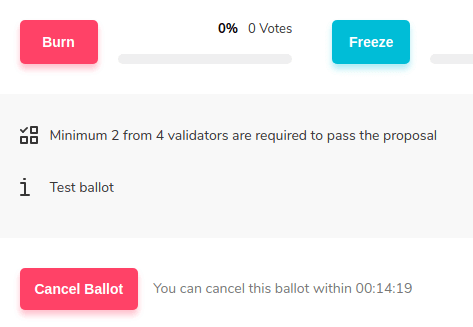-
Notifications
You must be signed in to change notification settings - Fork 43
Manage Emission Funds
From November 17, 2018 we increased Emission Supply by 2.5% to support self-sustainability. This was scheduled and described in POA Whitepaper, POA Token Supply, and RFC issue #14.
Therefore, starting from November 17, 2018 every block produces 2 POA instead of 1 POA: 1 POA is still for validator's reward and a remaining 1 POA is accrued to EmissionFunds smart contract which permanently accumulates these funds.
The EmissionFunds contract allows to perform the following actions on its balance: burn funds, hold funds, or send them to a specified address. Any of those actions can only be performed as a result of validators' voting with VotingToManageEmissionFunds smart contract which interacts with Governance DApp.
In order to create a new ballot, a validator should launch Governance DApp, open New Ballot page, and select the Emission Funds Ballot tab.

On that page, a validator should enter a ballot description and paste an address of funds receiver which the funds will be sent to if Send action obtains the majority of votes.
The field Current amount of funds is not editable and just shows the current balance of EmissionFunds contract.
Above the Add Ballot button we see the note with two dates:
-
The date from which a new ballot can be created (in local time). E.g., as in the screenshot above, it is
December 1, 2018 10:00 AM. That is, a new ballot can be created not earlier than this date. -
The date when a ballot will end (in local time). E.g., as on the screen above, the end date is
December 8, 2018 10:00 AM. This end date is 7 days in the future relative to the first date mentioned above.7 daysis so-calleddistribution threshold. The end date doesn't depend on the actual date of the beginning of voting. For example on the screen above, the voting can be started on3rd Decemberbut it will still have the end date ofDecember 8, 2018 at 10:00 AM. ReadTime limitationssection below for more info.
As a result of creating a ballot, its card will appear in a ballot card list. For example (the screenshot of test ballot's card in Sokol network):

- Validators can create a ballot of this type every
3 months. This period of time is calledemission release threshold. - Validators also have
distribution thresholdof 7 days max when they can make a decision about distribution. E.g. validator started a ballot 2 days afteremission release thresholdthen ballot may have 5 days or lessdistribution threshold. - A validator who created a ballot can cancel the ballot within 15 minutes right after its creation:

For example on the first screen above, emission release threshold is equal to December 1, 2018 10:00 AM. So, we add 7 days (distribution threshold) and get December 8, 10:00 AM as an end date of the ballot.
Let's assume that a validator created a new ballot on December 3 at 10:00 AM. So, validators will have 5 days to give their votes. After December 8, 10:00 AM the ballot can be finalized.
After that validators will be able to create the next ballot from March 1, 2019 10:00 AM and it will have an end date of March 8, 2019 10:00 AM. And so on.
- Note that only one ballot of this type can be created at a time. Validators cannot create a few ballots of this type in parallel: to be able to create a new ballot, the previous ballot must be finalized.
- In
Sokolnetwork we have reduced values ofemission release thresholdanddistribution threshold(for testing purposes):-
emission release thresholdis equal to7 days -
distribution thresholdis equal to3 days
-
-
Getting Started
-
Roles
- Master of Ceremony
- Validator
- Full Node Operator
-
Hard Forks
-
POA
-
POA Network Bridged to Stable ERC20 coin
-
Technical guides